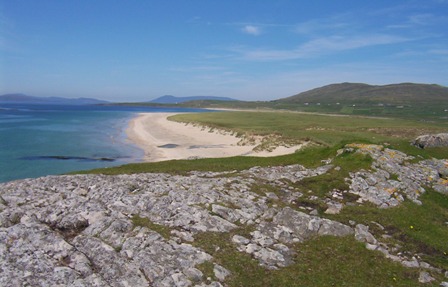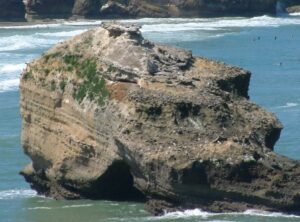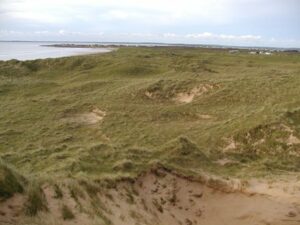Coastal areas are typically rich in biodiversity. This is the result of the interaction of the wind and waves, working together to shape the rocks and sand and produce a range of niches in which plants and animals can live. Our coastal lands contain a variety of habitats, ranging from the familiar Sand Dune systems to the rare machair grasslands.
Sand dunes form where waves encourage the accumulation of sand, and where prevailing onshore winds blow this sand inland. As the dune forms the wind starts to affect it by eroding sand particles from the windward side and depositing them on the leeward side. Gradually this action causes the dune to “migrate” inland, as it does so it accumulates more and more sand. The range of plant species associated with dunes changes as one moves inland – from pioneer species, such as Sea Rocket, to high dunes dominated by Marram Grass, to fiked dunes containing fecscue, rest harrow, lichens etc., to wetlands known as dune slack containing sedges and/or creeping willow.
Salt marshes are stands of vegetation that occur in marine and brackish water conditions on mud or peat that is wet, waterlogged or periodically submerged by the sea. They are typically found between the upper limits of the neap and spring tides in protected bays, estuaries, and other sections of sheltered coastline. Saltmarsh is widely distributed around the coast, but is often highly fragmented. The largest areas are generally associated with mudflats in our major estuaries and sea loughs such as the Broad Water Sea Lough in Mulroy Bay, Co. Donegal
Machair is a highly specialised and complex sandy coastal habitat that, in the entire world, only occurs in the northwest coasts of Ireland and Scotland. In Ireland it can be found along the west coast from Galway Bay to Malin Head, in Donegal, where gales and high winds are frequent. It comprises a flat or gently undulating sandy plain that develops in an oceanic location with a cool, moist climate. Formed when calcareous sand is blown in by prevailing winds from beaches and dunes, it is one of the rarest wildlife habitats in Europe. In Ireland it is a priority Annex I habitat listed on the EU Habitats Directive, which means it is afforded special protection and conservation.
Many of the coastal habitats in Ireland are protected as Natural Heritage Areas (NHAs), Special Protected Areas (SPAs) and Special Areas of Conservation (SACs).
For more information of Coastal Habitats in Ireland, species and the legislation that protects woodlands download the Notice Nature Coastal Factsheet



